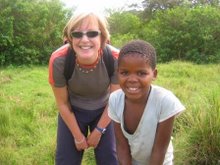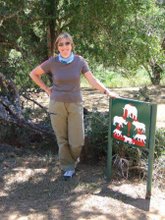We, rather painfully, got the hotel to write in Arabic the name of the tomb for us so we could show the bus drivers and find the right bus. They seemed to have no idea what we were talking about, in spite of our very best Arabic, but eventually, after a bit of twirling in the hotel foyer, they seemed to twig. Anyway, we did manage to get a bus - always a good thing in this town as they're about 10 percent of the price of a taxi. We left around 4.30, expecting things to start happening around 6, but were so efficient that we were at the cemetery before 5. Still, a few people were about, and there were tea ladies everywhere so we sat down, accompanied by a local with the rather unlikely name of Maurice, who told us a little bit about the ceremony, what we would see and where we should go. I was soon snaffled by a couple of young girls, who took me to the back of the tomb where the women were preparing food, so I could meet their grandmother. She wasn't that pleased to see me really, so I left and headed back to the main outdoor area in front of the tomb where the warm up was happening. Three older guys in white robes were banging rhythmically on drums, and moving round in a circle. Other men would jump into the circle and pretend to threaten them with sticks and they would mock fight. It all looked rather pantomine-like, but the crowd was really into it, clapping and laughing. There was a lot of laughter actually, which I hadn't expected. I had thought this would be a serious, if slightly cosmic, religious ceremony.





Some of the crowd, and the warm-up act for the Dervishes.
There were quite a few local people watching who took the opportunity to speak to the inevitable tourists. Max chatted with a guy who'd written a Master's thesis on Sufism, and I spoke to a couple of younger guys who were basically tour touts, but knew their stuff. The crowd was probably round a thousand when the main event started, as we'd been told, an hour before sunset. It went for round 90 minutes, with waves of frenzied chanting, clapping and drumming. Some of the Sufis who were allowed inside the large circle merely walked around, nodding and swaying, but some really did twirl and whirl, seemingly oblivious to all else around them. There were a couple of "administrators" who kept the crowd motivated to chant and clap. The crowd played a big part in generating the atmosphere that allowed the devout in the centre to abandon themselves. It was at times a strange phenomenon to witness, and also at times familiar - I could have been at a rock concert. There were some modern accessories - loudspeakers, microphones and more than a few cell phones - along with the more traditional sticks, braziers with incense, whips and instruments (and maybe some magic, I was quietly told), to help things along. The event was colourful and exotic, and it finished with a nice touch when we were invited to join others to eat freshly cooked lentils (courtesy of the ladies out the back). No women were overtly involved in the ritual, either as adherents or in the crowd generally, so I think their role was supportive shall we say!
The crowd surrounding the whirling ones kick off their shoes, clap and chant Allah's name faster and faster in unison, providing an hypnotic effect.
Among the adherents were many who looked and dressed unlike most Sudanese men, who are generally short haired, clean shaven, and tidy in white robes and turbans. They stood apart with dreadlocks, beards and a range of colourful clothing. Breathing in the smoke from the brazier is supposed to mean you will come back to Omdurman - and so I guess I shall!









No comments:
Post a Comment